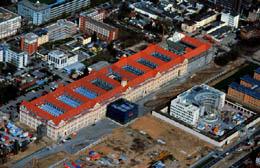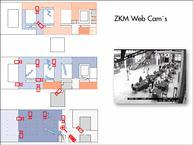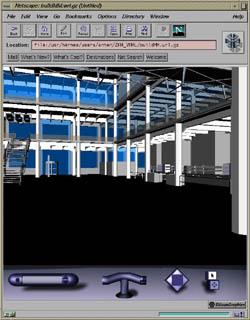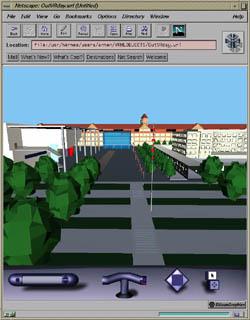 |
|
|
|
Archives & Museum Informatics info @ archimuse.com www.archimuse.com |

 |
The Museum of the Future |
 |
Technical details The ZKM has practically ALL the medium and high end hardware and software for sound and image creation, presentation and performance (a complete list can be supplied on request). Also some unusual devices such as a simulation platform, a motion controlled camera rig, and various virtual reality and spatialised audio systems. Interactive interfacing is also another area that is strongly supported. Our network technology is ATM (155 MB/sec), fast Ethernet (100 MB/sec) and normal Ethernet (10 MB/sec). There is a 2 MB/sec Internet connection, 50 MB/sec connection to the University of Karlsruhe. The main limitation regarding the technical facilities is the technical complexity of this sophisticated infrastructure which needs highly skilled management and maintenance, as well as a governmental salary structure that does not adequately compensate the qualifications of such people. Departments ZKM | Museum for Contemporary Art
Included in the exhibits displayed by the Museum for Contemporary Art are 'classical' works of the still-young genre of media art such as Bill Viola's 'The City of Man' and Nam June Paik's 'Passage'. Well-known video artists such as Gary Hill, Marie-Jo Lafontaine, Bruce Nauman and Fabrizio Plessi are represented with important works. After the neo-figuration of post-modernist painting, abstract and representationally abstracting images have returned to the foreground. This aspect is accentuated by the Museum for Contemporary Art, with a special focus being placed on contemporary German painting. The range of photography includes images by Thomas Struth, Thomas Ruff and Andreas Gursky; among the sculptures are works by Christian Boltanski, Ulrich Rueckriem and Imi Knoebel. In this interplay of different genres the Museum for Contemporary Art thus offers a comprehensive panorama of current art.
Private collections enrich the ZKM | Museum for Contemporary Art From fall 1999 onward, ZKM will be able to show first-class works from the collections of Frieder Burda, Josef Froehlich, Anni Graesslin, Friedrich Rentschler and Siegfried Weishaupt. They will be complemented by the collection of Count Panza di Biumo of Milan/Varese, which is devoted mainly to contemporary American art. The private collections include works by major contemporary artists such as Baselitz, Polke, Penck, Luepertz, Kiefer, Beuys, Warhol, Lichtenstein, Stella, Haring, Fontana, Oehlen, Mucha, Wols and many others besides. One of the largest groups of modern art collections will then be gathered together in the Museum for Contemporary Art.
ZKM | Media Museum
'The World of Games' provides visitors with an opportunity to experience at first hand the fascination exuded by computer games, as well as the dangers they harbor. The museum's 'laboratories' are concerned less with artistic content than with equipment, systems and techniques. Visitors are invited to experiment at workstations and acquire their own knowledge of media technology basics. The 'Salon Digital' is the museum's virtual wing and ZKM's window to the outside world. Visitors to the salon have full access to the Internet, and surfers on the Net are reciprocally invited to visit the ZKM|Media Museum via the same gateway. A regular program of events organized by visiting curators is foreseen; again, participation by Internet users will be welcomed.
ZKM | Media Library The Audio Collection is devoted to contemporary music, and places a particular emphasis on electroacoustic music. At present, the collection includes some 12,000 titles supplemented by scores, specialist literature, historical photographs and posters. A major role is played by the International Digital Electroacoustic Music Archives IDEAMA, which encompass all important compositions from the beginnings of electroacoustic music up to the present day. Another department presents the most important works of New Music. The designated purpose of the Video Collection is to raise awareness of video as an art form in its own right. It is the first collection of its kind in Germany concerned with presenting the history of video art. The current stock of more than 500 artists' videos accounts for 120 hours of running time. Another central aspect of the collection is the video magazine 'Infermental', which is a unique document of 1980s video art. An important task in the future will be the conservation of early videotapes already threatened by deterioration - thus, all tapes will be digitized. The shared print library of the ZKM and Academy of Design encompasses some 20.000 books and CD-ROMs. 120 periodicals are on hand. The library focuses on art in the 20th century - media art, above all, followed by architecture, design, media theory, film, photography, and electroacoustic music. The two research and development departments are the Institute for Visual Media and the Institute for Music and Acoustics .
ZKM | Institute for Visual Media Many works of art produced at the institute have won acknowledgment at international exhibitions, for instance at the Lyons Biennial, the 'Mediascape' show in the Guggenheim Museum, New York, or the Ars Electronica, Linz. Naturally, the works were also shown at the previous Multimediale festivals staged by the ZKM. Many works are the product of cooperation with internationally renowned research institutions and media centers such as the Intercommunication Center (ICC) in Tokyo (JAPAN) or Le Fresnoy in Tourcoing, France. The multimedia laboratory established by the institute in collaboration with the ZKM | Media Museum places a special focus on producing CD-ROMs with art content. The annual editions of the interactive CD-ROM magazine 'artintact', for example, have been produced in the laboratory since 1994.
ZKM | Institute for Music and Acoustics Software engineering is a further aspect of the institute's work. The composition software Common Music/Stella developed there by composer and programmer Heinrich Taube has meanwhile achieved international success - in particular at universities and electronic studios devoted to research and the training of composers. In the blue cube-shaped building that fronts the ZKM, the institute has at its disposal a superbly equipped recording studio. It allows the advanced technologies now becoming standard in the media industry to be incorporated in the creative production process from the first step onward.
National network The ZKM is also very closely associated (and shares the same building) with the Staatliche Hochschule für Gestaltung (State School of Design), The ZKM is connected to all the institutions belonging to the so-called Technology Region Karlsruhe and to all the local, national and international institutions (e.g. contemporary art museums, science museums, media art centers, media technology research centers) that have overlapping interests with the ZKM. The ZKM has structural relations with for instance the University of Karlsruhe (e.g. computer science department, computer graphics department, robotics department), and the Research Center Karlsruhe (e.g. robotics department). There is also a strong relationship with the GMD-German National Research Center for Information Technology.
International network In an increasingly interconnected world cultural institutions have to operate globally .The ZKM has an intensive exchange program with institutions all over the world. We are working together with American, European, Pacific and Asian universities, research centers and museums. The ZKM has close relations with other media cultural institutions such as the Guggenheim Museum (New York), the Museum of Contemporary Art in Strasbourg, France and the Le Fresnoy National Studio of Contemporary Arts (Tourcoing) France. The NTT InterCommunication Center (Tokyo) is one of the major partner Institutions of the ZKM and the closest one regarding the program, the infrastructure and the facilities. The ZKM has also cooperated with many other cultural and media art related institutions and events worldwide, as well as with many of the Goethe Institutes. There are also strong contacts with universities such as MIT Media Lab Mass. USA, Chulalongkorn University Bangkok and Baptist University Hong Kong ( the latter with a one-way student exchange program). The ZKM | Institute for Music and Acoustics works closely with comparable research institutions around the world; these include the IRCAM at the Centre Pompidou in Paris, and the Computer Music Center at Stanford University in the USA. In some cases this co-operation is formalized, in most cases it is done on project-by-project basis.
ZKM Strategy for the net
One aspect of the new version will be a "live" window into the building by the use of non-security-relevant web cameras . Virtual visitors would be enabled to have an actual view what is happening in the building or e.g. in the Media theater.
The ZKM opened its virtual presence on the Net using a new virtual reality technology standard in the web VRML in 1997. The whole building with many artworks, media installations and paintings are available for the public to visit the ZKM virtually. Now the ZKM is developing a simplified version of this model, which will allow even broader public to use their normal PC's to make a virtual tour. The ZKM shop has been online for nearly two years, but I have to admit that our shoppers still prefer to go offline for shopping.
Three more examples The Morphogenesis Project by Bernd Lintermann . In both systems users evolve a three dimensional organic object created
using genetic algorithms. The organic is defined by a genome, a set
of components, which is successively mutated by the users. Out of
six randomly generated mutations users select one, which in the next
step is the starting point for new mutations. This way users choose
a thread through a space out of approximately
"Global Bodies"
Third is the Catal Höyük Archaeology and Multimedia Project ( CHAMP) . One of the main tasks of CHAMP is to build a program that runs on all platforms, CD-ROM, the Internet and realtime. The objective of CHAMP is for the first time to link video and "virtual" computer reconstructions and archaeological data in an integrated database that will enhance scientific understanding of archaeological sites and presentation of cultural heritage sites to a wider audience and the development of new forms of long-term documentation in the context of new media and the "virtualmuseum". This project got the first prize from the MFG Agen cy (a state agency for Multimedia) and was presented in Cannes, France in February 1998 during the MILIA fair. Outlook Even more traditional museums, though changed by the way we will
use these technologies, will never become obsolete. As long there
is a need for museums, there will be the real, physical thing, with
real people inside, walking around looking at real artifacts and meeting
real people in real life. But the "digital" museum will
lead them to a better understanding and hopefully help them have more
fun. Dr.Gerd Schwandner Tel. +49 - 721 - 8100 1000 http://www.zkm.de
Send questions and comments to info@archimuse.com |


 The technical images of photography, video and holography have
taken their place alongside the classical genres of painting, graphics
and sculpture, and have drastically changed the world of art in the
process. The Museum for Contemporary Art meets the challenges posed
by these developments: it is a museum of all the arts, and combines
painting, graphics, sculpture, photography and media art. Its collection
of media art, one of the most extensive to be found in any museum,
is especially impressive in juxtaposition with the other genres: the
unmoving images geared towards contemplation are confronted with the
moving pictures on the monitors and projection surfaces. This dialogue
between different art forms opens up new perspectives for the future.
The technical images of photography, video and holography have
taken their place alongside the classical genres of painting, graphics
and sculpture, and have drastically changed the world of art in the
process. The Museum for Contemporary Art meets the challenges posed
by these developments: it is a museum of all the arts, and combines
painting, graphics, sculpture, photography and media art. Its collection
of media art, one of the most extensive to be found in any museum,
is especially impressive in juxtaposition with the other genres: the
unmoving images geared towards contemplation are confronted with the
moving pictures on the monitors and projection surfaces. This dialogue
between different art forms opens up new perspectives for the future. Most of the installations and works of media art were created directly
for the ZKM|Media Museum, and are associated with specific themes
it addresses. The Media Bodies section, for instance, shows how our
image of the human body is being altered by the new technologies and
in particular by simulation techniques. Notions sometimes playing
an exaggerated role in discussions about the new media - 'Cyber Space'
and 'Virtual Reality' are just two examples - are illuminated playfully
and critically by turns. The Media Visions section features a series
of imaginative installations offering visitors to the museum a glimpse
into the future of media such as books, films and theater. The ZKM|Media
Museum also houses an 'interactive art gallery' presenting a selection
of interactive works important to the genre's development history,
and shows the breadth meanwhile encompassed by the field. Masaki Fujihata`s
"Beyond Pages" is one work exhibited, Jeffrey Shaw's 'The
Legible City' another.
Most of the installations and works of media art were created directly
for the ZKM|Media Museum, and are associated with specific themes
it addresses. The Media Bodies section, for instance, shows how our
image of the human body is being altered by the new technologies and
in particular by simulation techniques. Notions sometimes playing
an exaggerated role in discussions about the new media - 'Cyber Space'
and 'Virtual Reality' are just two examples - are illuminated playfully
and critically by turns. The Media Visions section features a series
of imaginative installations offering visitors to the museum a glimpse
into the future of media such as books, films and theater. The ZKM|Media
Museum also houses an 'interactive art gallery' presenting a selection
of interactive works important to the genre's development history,
and shows the breadth meanwhile encompassed by the field. Masaki Fujihata`s
"Beyond Pages" is one work exhibited, Jeffrey Shaw's 'The
Legible City' another. The ZKM has developed a multiple strategy on the net to match a whole variety
of different activities from the artistic events to services for the
public and visitors. In general our net visitors are coming from all
over the world especially from the USA, Japan, France to name the
most active countries. Foreign visitors outnumber German visitors.
The ZKM provides the home page in German, English and French in full
version and an additional short version in Chinese characters. A new
design for the fourth version on the net will be developed and installed
in spring 1998.
The ZKM has developed a multiple strategy on the net to match a whole variety
of different activities from the artistic events to services for the
public and visitors. In general our net visitors are coming from all
over the world especially from the USA, Japan, France to name the
most active countries. Foreign visitors outnumber German visitors.
The ZKM provides the home page in German, English and French in full
version and an additional short version in Chinese characters. A new
design for the fourth version on the net will be developed and installed
in spring 1998.


 In the real space users additionally change the shape and behavior of the
life like organic object via an interface box. Both systems are coupled
and operate on the same data set constituting the genom, actions in
the web space effect the real space and vice versa. If a change on
the web happens , the organic in the real space slowly morphs towards
the web selection, a change in real space directly affects the next
web action. Morphogenesis was exhibited at the Multimediale 5 , October
18 - November 9 1997 at the ZKM.
In the real space users additionally change the shape and behavior of the
life like organic object via an interface box. Both systems are coupled
and operate on the same data set constituting the genom, actions in
the web space effect the real space and vice versa. If a change on
the web happens , the organic in the real space slowly morphs towards
the web selection, a change in real space directly affects the next
web action. Morphogenesis was exhibited at the Multimediale 5 , October
18 - November 9 1997 at the ZKM. For the opening of ZKM at 18th
and 19th October 1997 one of our major projects was an internet based
video-conferencing-perfomance with the title "
For the opening of ZKM at 18th
and 19th October 1997 one of our major projects was an internet based
video-conferencing-perfomance with the title " This project - both a CD-ROM and the net version -is an interdisciplinary
project between the Staatliche Hochschule für Gestaltung Karlsruhe,
the University of Cambridge (UK), the Universität Karlsruhe and
the ZKM.The ZKM begun 1992 with the production of the first three
dimensional interactive virtual computer animations about Catal Höyük.
Catal Höyük in the central anatolian highland in Turkey
is an archaeological site of immense international significance, providing
the first instance of complex settled life other than Jericho. Some
of the spectacular sculptures and paintings are 9000 years old and
provide a direct window into neolithic life.
This project - both a CD-ROM and the net version -is an interdisciplinary
project between the Staatliche Hochschule für Gestaltung Karlsruhe,
the University of Cambridge (UK), the Universität Karlsruhe and
the ZKM.The ZKM begun 1992 with the production of the first three
dimensional interactive virtual computer animations about Catal Höyük.
Catal Höyük in the central anatolian highland in Turkey
is an archaeological site of immense international significance, providing
the first instance of complex settled life other than Jericho. Some
of the spectacular sculptures and paintings are 9000 years old and
provide a direct window into neolithic life.